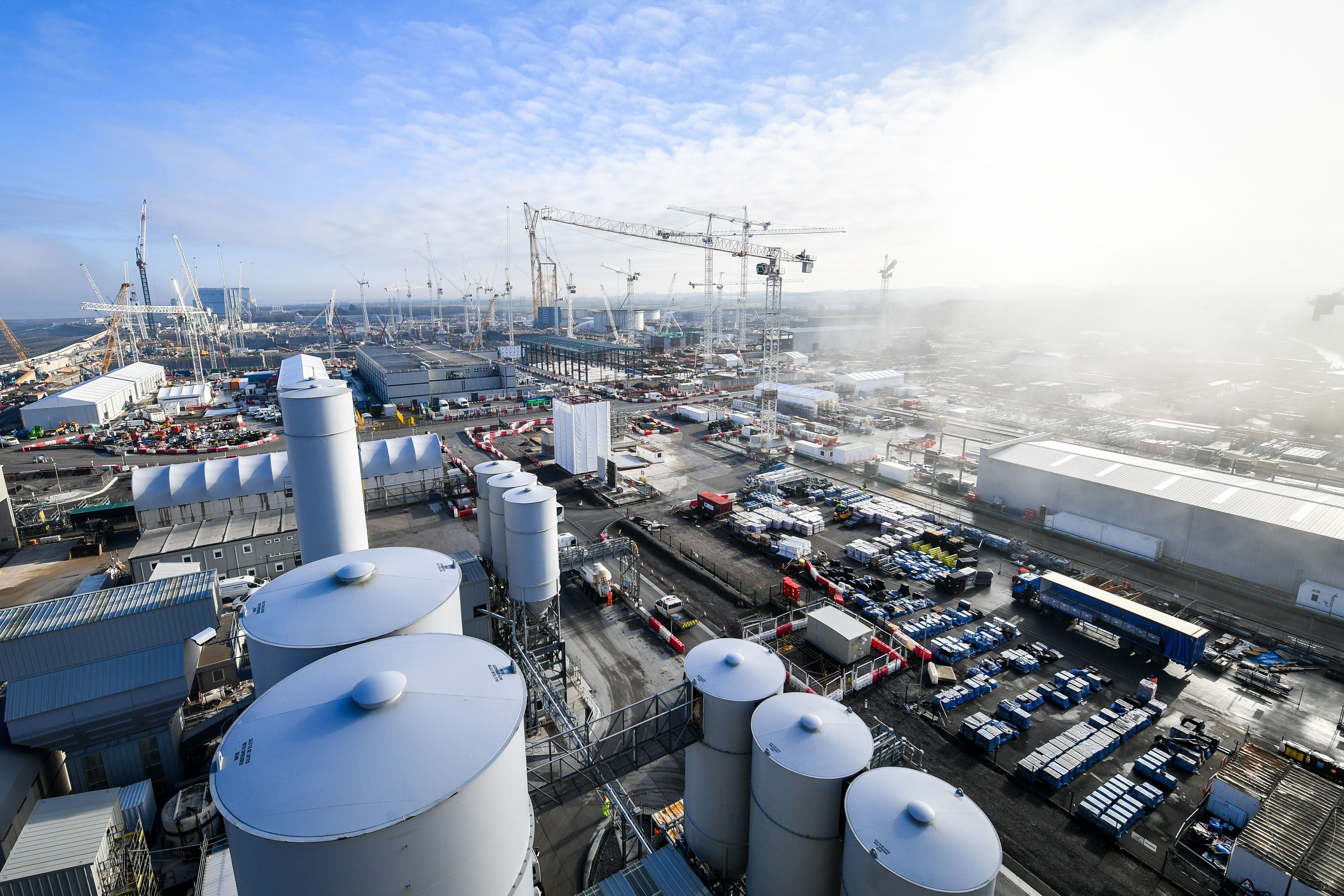It is a blustery September day on the Suffolk coast. A heron takes flight over piles of dirt on a scratchy bit of wasteland. The future site of the Sizewell C nuclear power station is not much to look at, but one day it could be home to two new reactors powering six million homes.
Julia Pyke, Sizewell C’s director for financial regulation, can picture the scene. She spent a decade helping get the Hinkley Point C plant off the ground. After many delays, that mega project of two reactors is now rising out of the Somerset countryside. “Having helped put together the case for Hinkley, I decided that the single most useful thing I could do for net zero was to get another nuclear power station built,” she said.
Sizewell, owned by French energy giant EDF, is the next large power station in the queue to be built after Hinkley Point C. It is already home to the Sizewell B plant, which, with its distinctive white dome, is visible from all along the coast. Inside its hot, thunderous turbine hall, turbines spin at nearly twice the speed of sound. At 27 years, its is the youngest of Britain’s dwindling fleet of nuclear power stations; there are five left, all run by EDF. But Sizewell B is growing long in the tooth, posing the question of what comes next.
Sizewell C will form part of a new strategy being fleshed out by Great British Nuclear, a body set up by Boris Johnson. Its design will be a copy of that at Hinkley, which should speed up delivery — but EDF reckons it will still cost £20 billion and take up to 12 years to build.
“It is, in effect, units three and four of Hinkley. We’ve done two, now look how much faster we can do these,” Pyke said.
The government’s goal, outlined in an energy security strategy earlier this year, is to generate 24GW of power from nuclear by 2050 — about double the peak capacity in 1994. Liz Truss appears willing to stick to such a goal, while talking up the prospects of small modular reactors (SMRs) built by Rolls-Royce. Yet the industry has a reputation for being costly, risky, and slow. Is there a chance of a new British nuclear age?
The sector’s fans certainly believe so — and war in Ukraine, they argue, has changed the debate. Energy security is top of the agenda. And nuclear power does not produce carbon emissions and could help us reach net zero by 2050.

Broadly speaking, our future options for nuclear are big and small. Big projects are difficult, saddled with cost overruns and delays. The government’s own impact assessment states that a new plant could take 17 years to build and cost up to 100 per cent more than its price at the time it is green lit. SMRs are much cheaper, at about £2 billion per unit, and can be built in a factory setting before final assembly on site. But they are untested. Rolls-Royce’s design is going through a four-year assessment.
Sizewell C will be built under a new model called the regulated asset base (Rab), which would pile upfront costs on consumers. In return, it could be more enticing to investors because it releases revenue in chunks. This would help raise the vast sums needed. Richard Nourse, founder of Greencoat Capital, which is weighing a nuclear fund, said: “Rab is attractive to financial institutions. It’s a good way in to a long-dated, inflation-linked, secure income. It’s got similarities with how the UK funded wind farms.”
EDF and the taxpayer are expected to take 20 per cent stakes each, with the balance to be found elsewhere. British Gas owner Centrica has indicated it could take an equity stake, depending on the terms. Its boss Chris O’Shea said more nuclear power could help make the UK an exporter of energy in the future.
“We need more electricity – more wind, more solar and more nuclear,” he said. “It’s in Centrica’s long-term interest to make sure that we get to the point where we’re not only self sufficient, but where we are now energy exporters, whether it’s electricity, or gas in the form of hydrogen eventually.”
After the equity portion, a large chunk of Sizewell C’s funding would come from debt.
EDF’s commitment after Sizewell is unclear. The company was 85 per cent owned by the French state, and President Macron is now pursuing a full nationalisation. He wants it to build six nuclear power stations in France, while it is also carrying out an expensive upgrade of its 56 existing plants. Meanwhile, its European Pressure Reactor (EPR) design — to be used at Hinkley and Sizewell — has hit teething problems in other countries.
Who else could build big plants in Britain if EDF were to bow out?
US giant Westinghouse, owned by Brookfield, the Canadian private equity giant makes the AP1000 reactor, which passed UK assessment. Under former owner Toshiba it was behind plans for a new plant in Cumbria, since scrapped.
Hitachi-GE is another option, but may be reluctant to return to the UK after writing off £2 billion in a stalled bid to build a plant at Wylfa on Anglesey.
Korean company Kepco has built a plant in the United Arab Emirates, but its design may need extra safety features to gain approval in Europe. Chinese company CGN is involved in Sizewell but is likely to be bought out.
Great British Nuclear could prevent a repeat of the Wylfa and Cumbria farragoes by offering a joined-up approach to financing and commissioning. It is being led by Simon Bowen, a former Babcock executive, who has handed in an initial report to the prime minister. Should Truss accept its proposals, the body may begin to take shape next year.
Great British Nuclear’s recommendations are not known, but insiders say that to hit the 24GW target, it will recommend a mixture of larger projects and SMRs. “You can’t treat nuclear power stations as individual little projects like PFI hospitals, you’ve got to treat them like building a fleet of warships,” said one source. This might mean encouraging a number of suppliers, to avoid having all our eggs in one basket.
Great British Nuclear’s role is also likely to include the reform of planning rules to speed through approval of nuclear sites. “The discussions around GBN has been about the barriers to development and how to best address them,” said Tom Greatrex, chief executive of the Nuclear Industry Association.
The “Britishness” of the UK’s nuclear fleet is questionable, reliant as it is on a French owner-operator and the kindness of strangers to fund and build new plants. Rolls-Royce’s proposed SMRs might redress that. SMRs would generate about a third of the energy of one of Hinkley’s reactors and would boast British intellectual property. It could even open up an export market should ministers commit to ordering the first batch.
Paul Stein, chairman of the Rolls-Royce SMR consortium, described its bid as an “indigenous solution” to Britain’s energy needs. “It will not only help our energy security situation, but also reindustrialise large areas of the UK,” he said.
Nothing in nuclear is straightforward. Large or small, developers will have to fight over a limited number of sites. The energy security strategy identified eight locations, all the sites of previous plants. But experts have warned some sites are at risk of flooding from rising sea levels.
Nuclear proponents champion its ability to deliver “baseload” power for when renewable energy falters. But others argue that wind and solar are cheaper. A study published by Oxford University last week said the rapid rollout of green energy could save trillions, while instead of enjoying the “exponentially decreasing costs” of renewables, nuclear has grown more expensive over time.
In Suffolk, yellow signs along the roads declare “there’s still time to stop Sizewell C!”. Alison Downes of the Stop C Sizewell C campaign group said: “All the construction delays and overspends on other EPR projects give us serious grounds for concern.” Downes also objected to the disruption and its impact on the environment. Not all locals agree: Stuart Rimmer, chief executive of East Coast College in Lowestoft, said it was “an opportunity to create the high-skilled, high paid jobs that our students very much need”.
Pyke is in no doubt that investors will ultimately sign on for big nuclear as a “safe home” for their money because it offers steady returns. She added: “Nuclear is going to be part of the UK’s energy mix. It’s great for carbon neutrality, it’s great for levelling up.”

France struggles to keep lights on
Europe’s energy crisis can hardly have come at a worse time for France.
For so long a net exporter of energy, France has been forced to go cap-in-hand to neighbours such as Germany for help — largely because of widespread outages at its fleet of nuclear reactors.
More than half of France’s 56 nuclear reactors are offline due to issues around corrosion. That has left their owner, EDF, struggling to generate enough electricity to meet the nation’s needs. Last week it warned it would take a €29 billion hit as production from nuclear power dipped to a 30-year low.
EDF has indicated it wants to get its reactors back online by the winter, but the problems have raised fears not just for France’s energy supply, but the UK, which typically imports a chunk of its energy via undersea cables called interconnectors.
Last year, 54 per cent of the UK’s electricity imports came from France — which was, until recently, a reliable source of low-cost power.
France built most of its nuclear fleet in a grand flurry from the 1970s onwards. The problems today stem from reactors simply growing old, according to Dr Mike Bluck, director of the Centre for Nuclear Engineering at Imperial College London.
“They’ve been successfully and reliably providing low-carbon electricity all this time,” he said. “If I bought a car and it ran for 20 years, and I looked at it and said, ‘look, it’s not starting’, I wouldn’t choose not to have a car. It’s just the car’s old.”
EDF, already facing a bill north of €50 billion to fund the so-called Grand Carénage programme to enhance reactor safety and extend the life of its nuclear plants, is under pressure to deliver.
Last week, Paris said it would switch off the lights on the Eiffel Tower early each night to save money, imperilling its reputation as the “city of light”.
This article was first published on September 18, 2022
